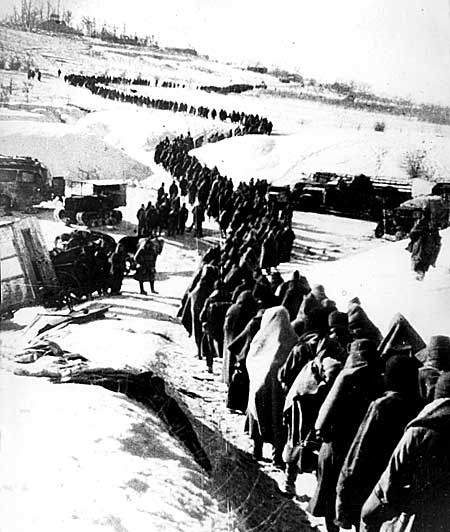The Invasion of Lithuania
On May 1st, the 5th, 10th, and 12th Armies all crossed over to Lithuania, fresh from their victory in Riga. The Soviet bulldozer ran on, even with their minor stall in Latvia. To the surprise of Vorshilov, there was little military presence; the Lithuanians, whom were GREATLY overestimated, contained a three-division army which they had pulled back to Kaunas in hope of creating some kind of defensive line. Seeing that Lithuania's three divisions were horribly unsupplied and were losing morale by the day, the three armies took some time to regroup.
By May 10th, all three armies, numbering 13 divisions in total were ready to cross the Nieman River and destroy the last obstacle in their course of Baltic dominance. Yet, Stalin did not wish to risk another Riga, especially with the time the Lithuanians had been given in preperation. Maskim Litvinov, the chief diplomat had suggested that a surrender be offered. And so, terms of surrender were drawn up by Litvinov and others. The document was forwarded to Kaunas, and it had been agreed to on May 11th. The terms were completely humiliating, but no one in the government was willing to fight after seeing what happened to Latvia. What they had agreed to was the disbanding of the Lithuanian army, the virtual dissolution of their government, and the occupation of Lithuania by Soviet troops. The Lithuanian President Smetona was so ashamed, he attempted to cross the German border to East Prussia with his family. However, since German border patrols at this time were ordered to be on top level caution, he was shot at, and killed along with his wife.
Upon the ratification of surrender, the Red Army crossed the Nieman and marched unopposed into Kaunas. But once they entered the city, to their suprise, some fire came from the rooftops of buildings. It was easy to supress these small attacks, but they would continue for years. Behind the scenes, the former commander of the Lithuanian army, Field Marshal Galvydus-Bykauskus, was organizing a resistance. He had been pressuring the government to allow his army to attack the Soviets during their ill-fated first assault on Riga, and then tried to convince them that he could hold out in the capital for weeks if they tried to gain the Germans' support. But no one was interested, so he decided to take action himself.
Soviet: 36 dead, 57 wounded.
Lithuanian: 112 dead, 286 wounded
Civilian: 20 dead, 86 wounded.
The Occupation
The war had officially began on March 7th, and than officially ended on May 11th. Lasting 47 days, it was almost half of what had originally been expected. Yet, it cost the Soviets more as well. The grand total of casualties (on all sides):
Soviet: 22,920 dead, 23,334 wounded.
Baltic: Estimated 85,500 casualties (max estimation, lower ones place it at 70,000).
Civilian: 52,000 (max estimation, lowers ones place it at 25,000, and the Soviet reports put it at less than 5,000!).
After the war, the occupied areas were divided into 4 military districts: Estonia, Latvia, Lithuania, and Memelland (marked area). These would later join the USSR.
Vorshilov oversaw the occupation of the Baltic States. They were supposedly allowed to choose their own government, but the elections for new officials were closely monitored, and mostly fixed by imported Soviet leaders, and the NKVD, which quickly followed the military. Attempts were made to make entry into the USSR as soon as possible, but negotations in Lithuania were stalled.
While both Estonia and Latvia had entered in the summer of 1936, it wasn't until February of the next year that Lithuania entered. The problem centered around the Soviet decision to seperate Memelland (which was claimed to be Lithuania) from it. The reason for this was that the area was claimed by Germany, and Stalin wanted to keep it as an "ace-in-the-hole" for future negotiations. Even the new government boldly argued for months, until "mysterious circumstances" led to the deaths of several key leaders. After this, ruling body of Lithuania became a direct extension of Stalin's will. Lithuania became the last Baltic state to join the Soviets after its "government" unanimously approved. But, resistance still continued there more than ever.
Soviet officers posing for a picture in occupied Latvia.
Lithuania is recognized as the state which provided the most resistance. Latvia was too devestated to offer a good amount of it, and while Estonia had its guerilla leaders, attacks only came once in a while. The Lithuanian army hadn't been destroyed, as with the other two states. It was officially "disbanded", but most soldiers had merely gone home to fight another day. As a result of this, Lithuania was more brutalized than any other country. Thousands were arrested and sent to prisons in Russia.
But the true climax of the terror began on in December of 1936. Galvydus-Bykauskus was discovered early that month, and tortured until he gave out the names of the main resistance leaders. The NKVD was dispatched to arrest the leaders, and this led to the finding of more information (such as a massive underground weapons route going through Poland). After he was no longer useful, Galvydus-Bykauskus was executed publically (other atrocities were committed, but they will not be discussed here). Not only was the resistance foundation shattered by this; the whole nation was in shock and mourning. As news spread, throughout the occupied territories, resistance didn't suddenly begin a retaliation. Instead, it died down to a murmer. Voroshilov, the military governer, gave a speech on the matter:
"Let the events of this day be a lesson to all enemies of the people: We shall protect [the people] in any way possible."
The enemies of the people, according to Stalin, were religion, capitalism, and the past governments of the new SSRs. These were each terminated during the occupation.
The streets of Tallinn, 1937.
















